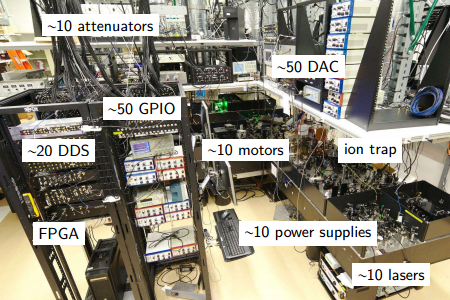

ARTIQ (Advanced Real-Time Infrastructure for Quantum physics) is a next-generation control system for quantum information experiments. It is being developed in partnership with the Ion Storage Group at NIST, and its applicability reaches beyond ion trapping.
Modern research on quantum information systems poses particular challenges to the control system:

ARTIQ features a high-level programming language, based on Python, that helps describing complex experiments. It is compiled and executed on dedicated FPGA hardware with nanosecond timing resolution and sub-microsecond latency.
The time-critical code (a kernel) running on the FPGA (the core device) is easily interfaced with Python code on the computer using a remote procedure call (RPC) mechanism.
The FPGA design is highly portable so that it can adapt to different laboratory setups and resist hardware obsolescence.
ARTIQ drivers for non-realtime devices can be run on remote machines with different operating systems.
The project also includes a graphical user interface, an experiment scheduling system, and databases for experiments, devices, parameters and results.
Technologies employed include Python, Migen, MiSoC/mor1kx, LLVM and llvmlite.

trigger.sync() # wait for trigger input
start = now() # capture trigger time
for i in range(3):
delay(5*us)
dds.pulse(900*MHz, 7*us) # first pulse 5 µs after trigger
at(start + 1*ms) # re-reference time-line
dds.pulse(200*MHz, 11*us) # exactly 1 ms after trigger
with sequential:
with parallel:
a.pulse(100*MHz, 10*us)
b.pulse(200*MHz, 20*us)
with parallel:
c.pulse(300*MHz, 30*us)
d.pulse(400*MHz, 20*us)
class Experiment(AutoDB):
def build(self):
self.ion1 = Ion(...)
self.ion2 = Ion(...)
self.transporter = Transporter(...)
@kernel
def run(self):
with parallel:
self.ion1.cool(duration=10*us)
self.ion2.cool(frequency=...)
self.transporter.move(speed=...)
delay(100*ms)
self.ion1.detect(duration=...)

If you don't mind getting your hands dirty (i.e. compiling software and FPGA bitstreams), it's easy to find out by yourself! The core device is based on the resource-efficient MiSoC system-on-chip design, and you can use a limited version of ARTIQ with the small and low-cost Papilio Pro board. Feel free to send feedback to the mailing list!
Note that ARTIQ is still in development and we expect to deploy a fully functional release (that will include a GUI) at NIST by June 2015. We are also working on making the installation procedure easier.